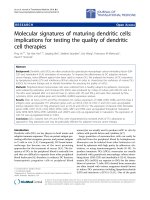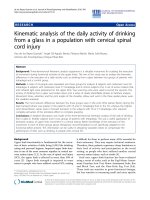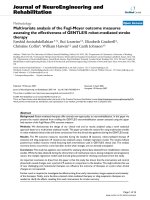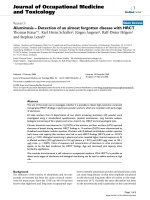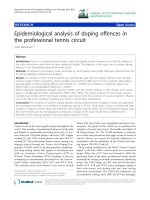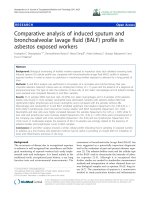báo cáo hóa học:" Molecular analysis of the apoptotic effects of BPA in acute myeloid leukemia cells" potx
Bạn đang xem bản rút gọn của tài liệu. Xem và tải ngay bản đầy đủ của tài liệu tại đây (294.37 KB, 8 trang )
BioMed Central
Page 1 of 8
(page number not for citation purposes)
Journal of Translational Medicine
Open Access
Research
Molecular analysis of the apoptotic effects of BPA in acute myeloid
leukemia cells
Paola Bontempo
1,2
, Luigi Mita
1,2,3
, Antonella Doto
1
, Marco Miceli
1
,
Angela Nebbioso
1
, Ilaria Lepore
1
, GianLuigi Franci
1
, Roberta Menafra
1
,
Vincenzo Carafa
1
, Mariarosaria Conte
1
, Floriana De Bellis
1
, Fabio Manzo
1
,
Vincenzo Di Cerbo
1
, Rosaria Benedetti
4
, Loredana D'Amato
1
,
Maria Marino
2,5
, Alessandro Bolli
2,5
, Giovanna Del Pozzo
2,6
,
Nadia Diano
2,3,6
, Marianna Portaccio
2,3
, Gustavo D Mita
3,4
,
Maria Teresa Vietri
1
, Michele Cioffi
1
, Ernesto Nola
1
, Carmela Dell'Aversana
1
,
Vincenzo Sica
1
, Anna Maria Molinari
1
and Lucia Altucci*
1,2
Address:
1
Dipartimento di Patologia generale, Seconda Università di Napoli, Via L. De Crecchio 7 Napoli, Italy,
2
Istituto Nazionale di Biostruttura
e dei Biosistemi, Viale Medaglie d'Oro,305, 00100 Roma, Italy,
3
Dipartimento di Medicina sperimentale, Seconda Università di Napoli, Via De
Crecchio, Napoli, Italy,
4
Dipartimento di Fisica, Università di Napoli 'Federico II', Napoli, Italy,
5
Dipartimento di Biologia, Università Roma Tre,
Viale Guglielmo Marconi 446, 00146 Roma, Italy and
6
Istituto di Genetica e Biofisica del CNR, Via P. Castellino 111, 80100 Napoli, Italy
Email: Paola Bontempo - ; Luigi Mita - ; Antonella Doto - ;
Marco Miceli - ; Angela Nebbioso - ; Ilaria Lepore - ;
GianLuigi Franci - ; Roberta Menafra - ; Vincenzo Carafa - ;
Mariarosaria Conte - ; Floriana De Bellis - ; Fabio Manzo - ;
Vincenzo Di Cerbo - ; Rosaria Benedetti - ;
Loredana D'Amato - ; Maria Marino - ; Alessandro Bolli - ;
Giovanna Del Pozzo - ; Nadia Diano - ; Marianna Portaccio - ;
Gustavo D Mita - ; Maria Teresa Vietri - ; Michele Cioffi - ;
Ernesto Nola - ; Carmela Dell'Aversana - ; Vincenzo Sica - ;
Anna Maria Molinari - ; Lucia Altucci* -
* Corresponding author
Abstract
Background: BPA (bisphenol A or 2,2-bis(4-hydroxy-phenol)propane) is present in the
manufacture of polycarbonate plastic and epoxy resins, which can be used in impact-resistant safety
equipment and baby bottles, as protective coatings inside metal food containers, and as composites
and sealants in dentistry. Recently, attention has focused on the estrogen-like and carcinogenic
adverse effects of BPA. Thus, it is necessary to investigate the cytotoxicity and apoptosis-inducing
activity of this compound.
Methods: Cell cycle, apoptosis and differentiation analyses; western blots.
Results: BPA is able to induce cell cycle arrest and apoptosis in three different acute myeloid
leukemias. Although some granulocytic differentiation concomitantly occurred in NB4 cells upon
BPA treatment, the major action was the induction of apoptosis. BPA mediated apoptosis was
Published: 18 June 2009
Journal of Translational Medicine 2009, 7:48 doi:10.1186/1479-5876-7-48
Received: 24 February 2009
Accepted: 18 June 2009
This article is available from: />© 2009 Bontempo et al; licensee BioMed Central Ltd.
This is an Open Access article distributed under the terms of the Creative Commons Attribution License ( />),
which permits unrestricted use, distribution, and reproduction in any medium, provided the original work is properly cited.
Journal of Translational Medicine 2009, 7:48 />Page 2 of 8
(page number not for citation purposes)
caspase dependent and occurred by activation of extrinsic and intrinsic cell death pathways
modulating both FAS and TRAIL and by inducing BAD phosphorylation in NB4 cells. Finally, also
non genomic actions such as the early decrease of both ERK and AKT phosphorylation were
induced by BPA thus indicating that a complex intersection of regulations occur for the apoptotic
action of BPA.
Conclusion: BPA is able to induce apoptosis in leukemia cells via caspase activation and
involvement of both intrinsic and extrinsic pathways of apoptosis.
Background
The Endocrine Disrupting Compounds are defined as
"exogenous substances that cause adverse health effects in an
intact organism, or its progeny, secondary to changes in endo-
crine function" (EEC, 1996). Their effects on humans, wild-
life and the environment have been subject of high
attention by the scientific community, since concerns
were first raised about them by Colborn [1]. Recently, the
potential of certain pesticides to act as EDCs has been con-
firmed. These include organometallic compounds, and
many other organochlorine compounds that are also toxic
and persistent [2,3], and many have been banned as a
result [2]. Other pesticides such as organophosphates, car-
bamates, triazines and pyrethroids that are less persistent
and less toxic than the organochlorines, were used to
replace them, but many are now confirmed or suspected
EDCs [4]. Conventional toxicological testing of pesticides
can miss the potential of a substance to disrupt the endo-
crine system, especially at the low concentrations likely to
be found in the environment. It is generally assumed that
chemical substances will show a simple monotonic dose-
response curve, but some ED pesticides have j-type dose-
response curves [5], whereby the toxic effects decrease as
the dose decreases, until at very low doses (often as low as
parts per billion or even trillion) their effects increase [5].
Of the more than 2,000 high-production volume chemi-
cals that are manufactured in or imported many are
widely used in consumer products. Among the many
chemicals is bisphenol A [BPA; 2,2-bis(4-hydroxyphe-
nyl)propane]. BPA is used in the manufacture of polycar-
bonate plastic and epoxy resins, which can be used in
impact-resistant safety equipment and baby bottles, as
protective coatings inside metal food containers, and as
composites and sealants in dentistry. Exposure to BPA is
thought to result primarily from ingestion of food con-
taining BPA [6,7]. At high doses, BPA demonstrates estro-
gen-like effects on uterine and prostate organ weights in
experimental animals. At doses below the putative lowest
observed adverse effect level, exposure to BPA has resulted
in decreased sperm production, increased prostate gland
volume, altered development and tissue organization of
the mammary gland, altered vaginal morphology and
estrous cycles, disruption of sexual differentiation in the
brain, and accelerated growth and puberty [8-16]. BPA is
of concern to environmental public health because of the
high potential for exposure of humans to these phenols
and their demonstrated animal toxicity. Recently, atten-
tion has focused on the carcinogenic adverse effects of
BPA. Thus, it is important to investigate the cytotoxicity
and apoptosis-inducing activity of these compounds
[17,18]. In the present manuscript, we decided to investi-
gate the effects of different doses of BPA on acute myeloid
leukemia models to understand the mechanism(s) of BPA
action in systems not directly related to the endocrine sys-
tem. We show indeed that BPA is able to induce apoptosis
in leukemia cells by activation of the initiator caspases 8,
9 and the effector caspases 37. Moreover we show that
many genomic and non-genomic players are influenced
by the action of BPA and contribute to its adverse effects.
Methods
Cell lines
All cell lines have been obtained from ATCC and routinely
cultured. NB4, U937, k562, and cells HL60, were grown at
37°C in air and 5% CO2 in RPMI 1640 medium
(GIBCO), supplemented with 10% heat-inactivated foetal
bovine serum (FBS), 1% l-glutamine, 1% ampicillin/
streptomycin and 0, 1% gentamicin. BPA (SIGMA) was
resuspended in ethanol and at the final concentration of
1 μM. All trans retinoic acid (SIGMA) (RA) was resus-
pended in ethanol and at the final concentration of 1 μM.
To understand the potential role of BPA leukemia cell
lines were treated with different concentrations of BPA
(10, 30, 60, 100 μM) for different times.
Cell cycle analysis
2.5 × 10
5
cells were collected and resuspended in 500 μl of
a hypotonic buffer (0.1% Triton X-100, 0.1% sodium cit-
rate, 50 μg/ml propidium iodide (PI), RNAse A). Cells
were incubated in the dark for 30 min. Samples were
acquired on a FACS Calibur flow cytometer using the Cell
Quest software (Becton Dickinson) and analysed with
standard procedures using the Cell Quest software (Bec-
ton Dickinson) and the ModFit LT version 3 Software
(Verity) as previously reported [19]. All the experiments
were performed in triplicate.
FACS analysis of apoptosis
Apoptosis was measured with Annexin V/PI double stain-
ing detection (Roche and Sigma-Aldrich, respectively) as
Journal of Translational Medicine 2009, 7:48 />Page 3 of 8
(page number not for citation purposes)
BPA induces dose dependent apoptosis and cell cycle block in acute myeloid leukemia cellsFigure 1
BPA induces dose dependent apoptosis and cell cycle block in acute myeloid leukemia cells. (A) Cell cycle and
apoptosis in NB4 cells after treatment with 10,30,60 and 100 μM BPA, ATRA (all-trans-retinoic acid) 1 μM and the combination
of ATRA 1 μM and BPA, at the indicated concentrations for 48 hrs. (B) Cell cycle analysis and apoptosis in K562 cells after 48
hrs of treatment with 60 and 100 μM BPA. (C) Cell cycle analysis and apoptosis in HL60 cells after treatment with 10, 30, 60
and 100 μM BPA for 48 hrs.
0
10
20
30
40
50
60
apoptosis
G2/M
S
G1
A+B 100
A+B 60
A+B 30
ATRA 1
BPA 100
BPA 60
BPA 30
BPA 10
ctr
% of NB4 cells
0
10
20
30
40
50
60
BPA 100
BPA 60
BPA 30
BPA 10
ctr
% of HL60 cells
0
10
20
30
40
50
60
ctr
BPA 100
BPA 60
% of K562 cells
Journal of Translational Medicine 2009, 7:48 />Page 4 of 8
(page number not for citation purposes)
recommended by the suppliers; samples were analysed by
FACS with Cell Quest technology (Becton Dickinson) as
previously reported [20,21]. We measured as apoptotic
fraction the Annexin V positive, PI negative cells. As sec-
ond assays the caspase 8, 9 and 7, 3 detection (B-Bridge)
was performed as recommended by suppliers and quanti-
fied by FACS (Becton Dickinson). NB4 cells were treated
for 48 h with 10-60-100 μM BPA.
Granulocytic differentiation assay
Granulocytic differentiation was carried out as previously
described [22]. Briefly, NB4 cells, treated for 48 h with 10-
30-60-100 μM BPA, ATRA 1 μM or with ATRA 1 μM and
BPA at the indicate prima concentrations, were harvested
and resuspended in 10 μl phycoerythrine-conjugated
CD11c (CD11c-PE) (Pharmingen). Control samples were
incubated with 10 μl PE or FITC conjugated mouse IgG1,
incubated for 30 min at 4°C in the dark, washed in PBS
and resuspended in 500 μl PBS containing PI (0.25 μg/
ml). Samples were analysed by FACS with Cell Quest tech-
nology (Becton Dickinson). PI positive cells have been
excluded from the analysis.
Western blot analyses
40 micrograms of total protein extracts were separated on a
15% polyacrylamide gel and blotted as previously
described [23]. Western blots were shown for p21 (Trans-
duction Laboratories, dilution 1:500), p27 c-19 (Santa
Cruz sc-528 rabbit, dilution 1:500), p16 (Santa Cruz sc-468
rabbit, dilution 1:500). For determination of Rb, pRb, p53,
ERalpha and cyclin D 35 μg of total protein extracts were
separated on a polyacrylamide gel and blotted. Antibodies
were: cyclin D (Zymed), pRb, p53, RB and ERalpha (Santa
Cruz). Total ERKs (Santa Cruz) were used to normalise for
equal loading. For quantification of TRAIL protein, 100 μg
of total protein extracts were separated on a 10% polyacry-
lamide gel and blotted. Western blots were shown for
TRAIL (Abcam Ab 16963-1). For determination of FAS,
FLIP-L and FLIP-S, BAD, pBAD and BCL2, 35 μg of total
protein extracts were separated on a 12% polyacrylamide
gel and blotted. Antibodies used were: FAS (ProSci xw-
7192, dilution 1:500), Flip (Alexis 804-429-C100, dilution
1:500), BAD (Cell signalling #9292, dilution 1:500), pBAD
(p-Bad ser 136, #9295 cell signalling, dilution 1:500), Bcl2
(Bcl2 (Ab-1) Oncogene Science, dilution 1:500). Total
ERKs were used to normalise for equal loading.
For determination of ERK2, pERK, Akt and pAkt, 35 μg of
total protein extracts were separated on a 12% polyacryla-
mide gel and blotted. Antibodies used were: ERK2 (Santa
Cruz sc-154, dilution 1:500), pERK (Santa Cruz sc-7383,
dilution 1:200), pAkt (Cell signalling cod 9271, dilution
1:1000) and Akt (Cell signalling Akt cod 9272, dilution
1:1000). For quantification of histone H3 acetylation, 40 μg
of total protein extracts were separated on a 15% polyacryla-
mide gel and blotted. Antibodies used were: acetylated his-
tone H3 (Upstate cat. 06-599, dilution 1:500). Total ERKs
were used to normalise for equal loading.
Results
BPA induces dose dependent apoptosis in acute myeloid
leukemia cells
To understand the potential role of BPA in biological sys-
tems of leukemias we tested the action of BPA in three
different acute myeloid leukemia models such as NB4,
BPA induces dose dependent differentiation in NB4 cellsFigure 2
BPA induces dose dependent differentiation in NB4
cells. (A) CD11c expression levels measured by FACS after
48 h of treatment with 10,30,60 and 100 μM BPA. (B) CD11c
expression levels after treatment with ATRA 1 μM or with
the combination of ATRA 1 μM and BPA at the indicated
concentrations for 48 hrs. Note that PI positive cells have
been excluded from the analysis.
0
5
10
15
20
BPA 100
BPA 60
BPA30
BPA 10
ctr
% of CD11c+ PI- NB4 cells
a
0
20
40
60
80
100
A+B 100
A+B 60
A+B 30
ATRA 1
ctr
% of CD11c+ PI- NB4 cells
b
Journal of Translational Medicine 2009, 7:48 />Page 5 of 8
(page number not for citation purposes)
HL60 and K562 cells. As it is shown in Fig. 1, different
concentrations of BPA are able to induce an increase of
the sub-G1 peack in all the cell lines tested, HL60 being
the most resistant one. In NB4 cells, a model from pro-
myelocytic leukemia containing the fusion protein PML-
RARα and sensitive to retinoids, the highest concentra-
tion of BPA used induces around 38% of apoptosis after
48 hrs. This apoptosis is not synergistically modulated
by the double treatment with 1 μM Retinoic Acid (RA) as
shown in Fig. 1A. Differently, cell cycle arrest seems to be
affected by the double treatment, showing an increase of
the G1 peack at low dose BPA (30 μM) and an increase
of the G2-M fraction of cells at the highest concentration
of BPA (100 μM). Differently, in the K562 cells, a model
of AML derived from a CML containing the Philadelphia
chromosome, the treatment with BPA showed an
increase of cell death proportional to the dose increase of
BPA, together with a G1 peack at the lower dose and a
G2-M increase at the higher dose (Fig. 1B). Finally, HL60
cells showed an increase of apoptosis at the higher dose
of BPA (100 μM) in agreement with what reported previ-
ously [17]. This increase is directly proportional with the
enrichment in G1 phase of HL60 cells upon treatment
with increasing doses of BPA (Fig. 1C).
BPA induces dose dependent differentiation in NB4 cells
That BPA was able to induce apoptosis and to influence
the cell cycle of NB4 cells, prompted us to check its effects
on granulocytic differentiation of these cells. As shown in
Fig. 2A by FACS analyses, BPA is able to differentiate NB4
cells versus granulocytes in a dose dependent manner.
However, the effect was weak if compared with the one of
RA at the same time in the NB4 cells (Fig. 2B), thus show-
ing that BPA preferentially activates apoptotic actions in
respect to differentiative effects in these cells.
BPA induces apoptosis via caspase activation in NB4 cells
To better identify which apoptotic pathway is activated by
BPA, we tested by FACS analyses the initiator and effector
caspases activation in NB4 cells after 48 h treatment with
BPA. As it is shown in Fig. 3, both caspase 8 (Fig. 3A) and
9 (Fig. 3B) are cleaved and active upon BPA treatment.
Note that caspase 8 resulted more active, suggesting a
prior activity of BPA on the extrinsic pathway of apoptosis
BPA induces apoptosis via caspase activation in NB4 cellsFigure 3
BPA induces apoptosis via caspase activation in NB4 cells. Caspase 8, 9 and 37 assays have been carried out by FACS
analysis in NB4 cells after 48 h of incubation with the indicated concentrations of BPA.
0
5
10
15
20
BPA 100
BPA 60
BPA 10
ctr
% of caspase 9 active cells
0
10
20
30
40
BPA 100
BPA 60
BPA 10
ctr
% of caspase 8 active cells
0
5
10
15
20
BPA 100
BPA 60
BPA 10
ctr
% of caspase 3-7 active cells
ab c
Journal of Translational Medicine 2009, 7:48 />Page 6 of 8
(page number not for citation purposes)
BPA induces modulation of cell cycle regulators and apop-totic players in NB4 cellsFigure 4
BPA induces modulation of cell cycle regulators and
apoptotic players in NB4 cells. (A) Western blot analysis
showing p21, p27, p16, cyclin D1 and RB expression levels in
NB4 cells treated with 60 μM BPA for 2, 4 and 6 days. (B)
Western blot analysis showing TRAIL, FAS, Flip-L and Flip-S
expression levels in NB4 cells treated with 60 μM BPA for
the indicated days. (C) Western blot analysis showing BCL2
and pBAD expression levels after treated with 60 μM BPA
for the indicated days. Total ERKs expression levels account
for equal loading.
p21
p16
p27
D1
Rb
ERKs
C 2 4 6
Days
C 2 4 6
Days
TRAIL
FAS
Flip-L
Flip-S
ERKs
pBAD
BCL2
ERKs
C 2 4 6
a
b
c
BPA induces modulation of ERK and AKT phosphorylation and increase of histone acetylation in NB4 cellsFigure 5
BPA induces modulation of ERK and AKT phosphor-
ylation and increase of histone acetylation in NB4
cells. (A) Western blot analysis showing ERK and AKT phos-
phorylation in NB4 cells treated with 60 μM BPA at the
times indicated times; (B) Western blot analysis of the
acetylation levels of Histone H3 in NB4 cells treated for 2, 4
and 6 days with 60 μM BPA. ERKs expression levels account
for equal loading); (C) Western blot analysis of the phospho-
rylation levels of Rb and p53 expression in NB4 cells treated
for 2, 4 and 6 days with 60 μM BPA. ERKs expression levels
account for equal loading); (D) Western blot analysis of the
expression levels of ER alpha in NB4 cells treated for 2, 4 and
6 days with 60 μM BPA. As positive control for the ER alpha
detection (indicated as +) 25 μg of MCF7 protein extracts
have been used. ERKs expression levels account for equal
loading.
ERK2
pERK
pAKT
AKT
C 5 10 20 75 120
min
AcH3
ERKs
C 2 4 6
Days
a
b
+
C 2 4 6
Days
ERKs
ERKs
c
d
pRb
p53
ER-alpha
C 2 4 6
Journal of Translational Medicine 2009, 7:48 />Page 7 of 8
(page number not for citation purposes)
at least as time scale. As expected, caspase 37, which are
downstream of caspase 8 and 9, resulted activated by
medium (60) and high doses (100) of BPA.
BPA induces modulation of cell cycle regulators and
apoptotic players in NB4 cells
That BPA influenced both cell cycle progression and apop-
tosis of acute myeloid leukemias has been clarified by
these results. To understand which molecular events
underlie to these effects, we have tested its action on
known cell cycle regulators in NB4 cells in a time depend-
ent manner. As shown in Fig 4A, p21, p27 and p16
together with RB are up-regulated by BPA at the 60 μM
dose, whereas cyclin D1 which is known to modulate pro-
liferation gets decreased. This scenario is reminiscent of a
cell cycle block regulated at the molecular level. At the
same time, checking for apoptotic key players we found
that both FAS and TRAIL are up-regulated already at day 2
of treatment, while Flip-L is transiently up-regulated and
then down-regulated, whereas Flip-S is down regulated
(Fig. 4B). At the mitochondria cell death level, we could
not find modulation of BCL2, but we could see increased
phosphorylation of BAD (Fig. 4C) thus confirming that
both pathways (extrinsic and intrinsic) gets activated by
BPA in NB4 cells.
BPA induces modulation of ERK, AKT and Rb
phosphorylation and increase of histone acetylation in
NB4 cells
To better focus the activity of BPA in acute myeloid leuke-
mia models, we decided to check whether BPA can also
modulate non genomic actions. As shown in Fig. 5, BPA
induce a decrease of ERK, Rb and AKT phosphorylation
thus indicating that anti-proliferative actions occur by
induction of non genomic pathways by 60 μM of BPA in
NB4 cells. Note that p53 expression levels stayed
unchanged (Fig. 5c). In agreement with these findings,
histone H3 acetylation is increased upon BPA treatment
suggesting an effect (direct or indirect) on chromatin
accessibility of BPA (Fig. 5B).
Discussion
The Endocrine Disrupting Compounds have been subject
of high attention by the scientific community, since con-
cerns have been raised about their actions and potential
toxicities. Among the many chemicals, BPA is used in the
assemble of polycarbonate plastic and epoxy resins, used
in impact-resistant safety equipment and baby bottles, as
protective coatings inside metal food containers, and as
composite and sealant in dentistry. Exposure to BPA is
thought to result primarily from ingestion of food con-
taining BPA [6,7]. BPA is of concern to environmental
public health because of its toxicity. At high doses, BPA
demonstrates estrogen-like effects in experimental ani-
mals, but effects independent from its endocrine modu-
lating function have been poorly investigated. Thus, it is
central to investigate the cyto-toxicity and apoptosis-
inducing activities of BPA at the molecular level. The fact
that BPA is able to induce effects on cell cycle and apopto-
sis in AML models indicates that BPA actions can go
beyond the endocrine interference. This is also demon-
strated by the fact that NB4 cells do not display detectable
levels of ER alpha. Thus suggesting that effects of BPA in
this cells are largely ER independent (Fig. 5d). This notion
is a key point considering that BPA is industrially used and
that its effects can cumulate. Although the properties seen
on granulocytic differentiation are minor when compared
to those of RA, the fact that BPA is used in equipments and
baby bottles makes also these weak effects of significance.
Even more interesting is the induction of cell death which
is clearly specifically regulated at the molecular level.
Indeed, the fact that three different cell lines respond with
apoptosis to BPA treatment and that this effect seems to be
dose dependent indicates that this is a general feature of
BPA treatment and that this might be reproduced in many
other cells. These evidences are exciting from several point
of view: if from one side we might consider the induction
of apoptosis as an interesting anti-cancer action, on the
other side we have to keep in mind that these effects might
also be elicited in normal cells in the different compart-
ments of the human body and thus might contribute to
the toxicity of BPA. The regulation of caspase-dependent
pathways of apoptosis suggests a specific action on the
extrinsic and intrinsic pathways of apoptosis which is con-
firmed by the clear induction of Fas and TRAIL and by Flip
down regulation in NB4 cells. Even if our data would sup-
port a model in which the extrinsic pathway of apoptosis
is more active, we do not exclude the importance of the
mitochondria de-regulation of apoptosis which is indeed
confirmed by caspase 9 activation and BAD phosphoryla-
tion. Considering that many clinical treatments target
apoptosis at the present, our data suggest that the contact
or the assumption of BPA might increase the effects of a
on-going treatment in humans, apart, of course, having
effects on its own. Finally, the fact that BPA decreases the
activity of ERK and AKT well integrates with its anti-prolif-
erative and apoptotic actions suggesting that the cross-talk
of different molecular actions contribute to the cell cycle
arrest and to the apoptosis in human biological systems.
The hyperacetylating effect shown on histone H3 con-
firms the property of BPA to modulate the chromatin in a
more accessible state thus corroborating the hypothesis
that BPA contributes with a plethora of different effects to
the induction of cell cycle arrest, weak differentiation and
apoptosis in a specific and molecularly defined manner. If
the hyperacetylation upon BPA treatment is a direct or
indirect effect on chromatin, remains to be established.
More characterized studies on BPA exposed population in
healthy or unhealthy status will decipher in the future the
real impact of these molecular actions.
Journal of Translational Medicine 2009, 7:48 />Page 8 of 8
(page number not for citation purposes)
Conclusion
Our data strongly indicate that BPA has molecular activi-
ties that go much beyond its ED function. These actions
have been well focused as cell cycle arrest and apoptosis
and the molecular pathways involved have been identi-
fied. This knowledge clearly shows that BPA effects have to
be considered independently of its ED action and might
help in the understanding of the adverse effects caused in
humans.
Abbreviations
AKT: RAC-alpha serine/threonine-protein kinase; AML:
Acute Myeloid Leukemia; ATRA: All Trans Retinoic Acid;
BAD: Bcl2 Antagonist of cell Death, BCL2-associated
death promoter; BCL2: B Cell Lynphoma 2; BPA: Bisphe-
nol A or 2,2-bis(4-hydroxy-phenol)propane; CML:
Chronic Myeloid Leukemia; EDC: Endocrine Disruptor
Compounds; ED: Endocrine Disruptor; ERK: Extracellular
Signal-Regulated Kinase; FAS: Apoptosis-mediating Sur-
face Antigen, Tumor necrosis factor receptor superfamily
member 6; FLIP: FLICE Inhibitor Protein; TRAIL: TNF
Related Apoptosis Inducing Ligand; RA: Retinoic Acid; RB:
Retinoblastoma.
Competing interests
The authors declare that they have no competing interests.
Authors' contributions
PB, LM, AD, MM, AN, IL, GF, RM, VC, MC, FDB, FM, CDA,
VDC, MM, AB, GDP, ND, M, LD, MTV, MC, RB, EN, VS,
GDM and AM contributing in performing the experiments
shown and in the conceptual understanding of the results.
PB and LA critically discussed the experimental data and
wrote the manuscript.
Acknowledgements
In memory of Ettore M. Schiavone. The work in the author's laboratories
has been supported by: AIRC (LA), HEALTH-F2-2007-200620, HEALTH-
F4-2007-200767, HEALTH-F4-2009-221952, la Regione Campania L5,
annualità 2005, Fondazione Luigi Califano. Dr A. Bolli has been supported
by a grant from the National Institute of Biostructures and Biosystems
(INBB).
References
1. Colborn T, vom Saal FS, Soto AM: Developmental effects of
endocrine-disrupting chemicals in wildlife and humans. Envi-
ron Health Perspect 1993, 101:378-384.
2. Vandelac L: Endocrine disruption agents: environment, health,
public policies, and the precautionary principle. Bull Acad Natl
Med 2000, 184:1477-1486. discussion 14871490
3. Vasseur P, Cossu-Leguille C: Linking molecular interactions to
consequent effects of persistent organic pollutants (POPs)
upon populations. Chemosphere 2006, 62:1033-1042.
4. Cheek AO, Kow K, Chen J, McLachlan JA: Potential mechanisms
of thyroid disruption in humans: interaction of organochlo-
rine compounds with thyroid receptor, transthyretin, and
thyroid-binding globulin. Environ Health Perspect 1999,
107:273-278.
5. Welshons WV, Thayer KA, Judy BM, Taylor JA, Curran EM, vom Saal
FS: Large effects from small exposures. I. Mechanisms for
endocrine-disrupting chemicals with estrogenic activity.
Environ Health Perspect 2003, 111:994-1006.
6. Kang JH, Kondo F, Katayama Y: Human exposure to bisphenol A.
Toxicology 2006, 226:79-89.
7. Vandenberg LN, Hauser R, Marcus M, Olea N, Welshons WV:
Human exposure to bisphenol A (BPA). Reprod Toxicol 2007,
24:139-177.
8. Durando M, Kass L, Piva J, Sonnenschein C, Soto AM, Luque EH,
Munoz-de-Toro M: Prenatal bisphenol A exposure induces pre-
neoplastic lesions in the mammary gland in Wistar rats. Envi-
ron Health Perspect 2007, 115:80-86.
9. Howdeshell KL, Hotchkiss AK, Thayer KA, Vandenbergh JG, vom Saal
FS: Exposure to bisphenol A advances puberty. Nature 1999,
401:763-764.
10. Howdeshell KL, Wilson VS, Furr J, Lambright CR, Rider CV, Blystone
CR, Hotchkiss AK, Gray LE Jr, et al.: A mixture of five phthalate
esters inhibits fetal testicular testosterone production in the
sprague-dawley rat in a cumulative, dose-additive manner.
Toxicol Sci 2008, 105:153-165.
11. Kubo K, Arai O, Ogata R, Omura M, Hori T, Aou S, et al.: Exposure
to bisphenol A during the fetal and suckling periods disrupts
sexual differentiation of the locus coeruleus and of behavior
in the rat. Neurosci Lett 2001, 304:73-76.
12. Kubo K, Arai O, Omura M, Watanabe R, Ogata R, Aou S: Low dose
effects of bisphenol A on sexual differentiation of the brain
and behavior in rats. Neurosci Res 2003, 45:345-356.
13. Richter CA, Birnbaum LS, Farabollini F, Newbold RR, Rubin BS, Tal-
sness CE, Vandenbergh JG, Walser-Kuntz DR, vom Saal FS: In vivo
effects of bisphenol A in laboratory rodent studies. Reprod
Toxicol 2007, 24:199-224.
14. Rubin BS, Lenkowski JR, Schaeberle CM, Vandenberg LN, Ronsheim
PM, Soto AM: Evidence of altered brain sexual differentiation
in mice exposed perinatally to low, environmentally relevant
levels of bisphenol A. Endocrinology 2006, 147:3681-3691.
15. Schonfelder G, Flick B, Mayr E, Talsness C, Paul M, Chahoud I: In
utero exposure to low doses of bisphenol A lead to long-
term deleterious effects in the vagina. Neoplasia 2002,
4:98-102.
16. Timms BG, Howdeshell KL, Barton L, Bradley S, Richter CA, vom Saal
FS, et al.: Estrogenic chemicals in plastic and oral contracep-
tives disrupt development of the fetal mouse prostate and
urethra. Proc Natl Acad Sci USA 2005, 102:7014-7019.
17. Terasaka H, Kadoma Y, Sakagami H, Fujisawa S: Cytotoxicity and
apoptosis-inducing activity of bisphenol A and hydroquinone
in HL-60 cells. Anticancer Res 2005, 25:2241-2247.
18. Terasaka H, Morshed SR, Hashimoto K, Sakagami H, Fujisawa S: Hyd-
roquinone-induced apoptosis in HL-60 cells. Anticancer Res
2005, 25:161-170.
19. Scognamiglio A, Nebbioso A, Manzo F, Valente S, Mai A, Altucci L:
HDAC-class II specific inhibition involves HDAC proteas-
ome-dependent degradation mediated by RANBP2. Biochim
Biophys Acta 2008, 1783:2030-2038.
20. Altucci L, Rossin A, Raffelsberger W, Reitmair A, Chomienne C,
Gronemeyer H: Retinoic acid-induced apoptosis in leukemia
cells is mediated by paracrine action of tumor-selective
death ligand TRAIL. Nat Med 2001, 7:680-686.
21. Nebbioso A, Clarke N, Voltz E, Germain E, Ambrosino C, Bontempo
P, Alvarez R, Schiavone EM, Ferrara F, Bresciani F, Weisz A, de Lera
AR, Gronemeyer H, Altucci L: Tumor-selective action of HDAC
inhibitors involves TRAIL induction in acute myeloid leuke-
mia cells. Nat Med 2005, 11:77-84.
22. Mai A, Valente S, Nebbioso A, Simeoni S, Ragno R, Massa S, Brosch
G, De Bellis F, Manzo F, Altucci L: New pyrrole-based histone
deacetylase inhibitors: Binding mode, enzyme- and cell-
based investigations. Int J Biochem Cell Biol 2009, 41:235-247.
23. Mai A, Cheng D, Bedford MT, Valente S, Nebbioso A, Perrone A, Bro-
sch G, Sbardella G, De Bellis F, Miceli M, Altucci L: epigenetic mul-
tiple ligands: mixed histone/protein methyltransferase,
acetyltransferase, and class III deacetylase (sirtuin) inhibi-
tors. J Med Chem 2008, 51:2279-2290.


